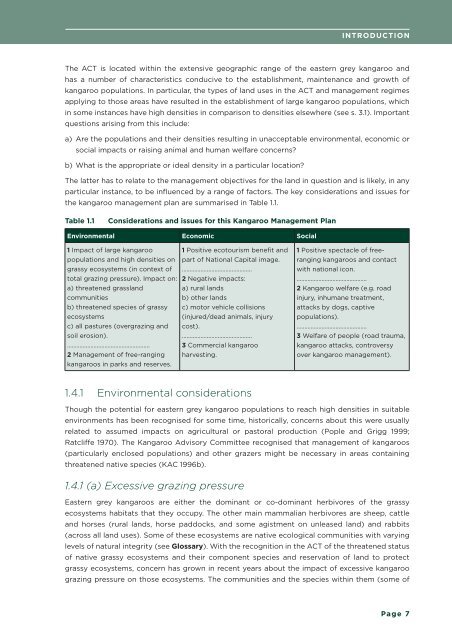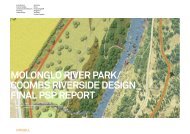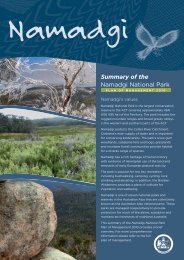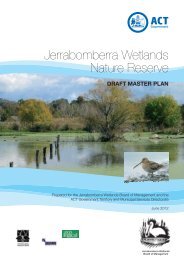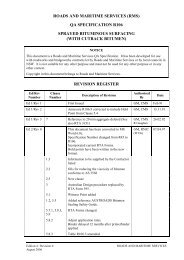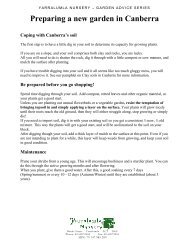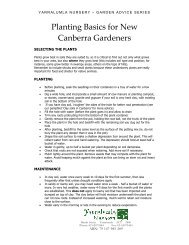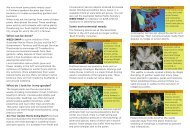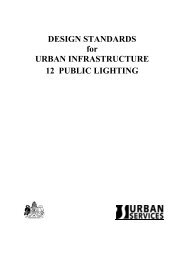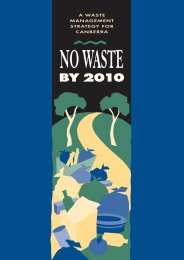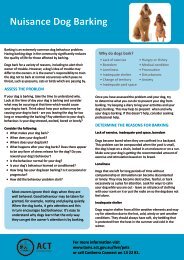Kangaroo Managment Plan - Territory and Municipal Services - ACT ...
Kangaroo Managment Plan - Territory and Municipal Services - ACT ...
Kangaroo Managment Plan - Territory and Municipal Services - ACT ...
Create successful ePaper yourself
Turn your PDF publications into a flip-book with our unique Google optimized e-Paper software.
INTRODUCTION<br />
The <strong>ACT</strong> is located within the extensive geographic range of the eastern grey kangaroo <strong>and</strong><br />
has a number of characteristics conducive to the establishment, maintenance <strong>and</strong> growth of<br />
kangaroo populations. In particular, the types of l<strong>and</strong> uses in the <strong>ACT</strong> <strong>and</strong> management regimes<br />
applying to those areas have resulted in the establishment of large kangaroo populations, which<br />
in some instances have high densities in comparison to densities elsewhere (see s. 3.1). Important<br />
questions arising from this include:<br />
a) Are the populations <strong>and</strong> their densities resulting in unacceptable environmental, economic or<br />
social impacts or raising animal <strong>and</strong> human welfare concerns?<br />
b) What is the appropriate or ideal density in a particular location?<br />
The latter has to relate to the management objectives for the l<strong>and</strong> in question <strong>and</strong> is likely, in any<br />
particular instance, to be influenced by a range of factors. The key considerations <strong>and</strong> issues for<br />
the kangaroo management plan are summarised in Table 1.1.<br />
Table 1.1<br />
Considerations <strong>and</strong> issues for this <strong>Kangaroo</strong> Management <strong>Plan</strong><br />
Environmental Economic Social<br />
1 Impact of large kangaroo<br />
populations <strong>and</strong> high densities on<br />
grassy ecosystems (in context of<br />
total grazing pressure). Impact on:<br />
a) threatened grassl<strong>and</strong><br />
communities<br />
b) threatened species of grassy<br />
ecosystems<br />
c) all pastures (overgrazing <strong>and</strong><br />
soil erosion).<br />
………………………………………….....<br />
2 Management of free-ranging<br />
kangaroos in parks <strong>and</strong> reserves.<br />
1 Positive ecotourism benefit <strong>and</strong><br />
part of National Capital image.<br />
………………………………………<br />
2 Negative impacts:<br />
a) rural l<strong>and</strong>s<br />
b) other l<strong>and</strong>s<br />
c) motor vehicle collisions<br />
(injured/dead animals, injury<br />
cost).<br />
………………………………………<br />
3 Commercial kangaroo<br />
harvesting.<br />
1 Positive spectacle of freeranging<br />
kangaroos <strong>and</strong> contact<br />
with national icon.<br />
………………………………………<br />
2 <strong>Kangaroo</strong> welfare (e.g. road<br />
injury, inhumane treatment,<br />
attacks by dogs, captive<br />
populations).<br />
………………………………………<br />
3 Welfare of people (road trauma,<br />
kangaroo attacks, controversy<br />
over kangaroo management).<br />
1.4.1 Environmental considerations<br />
Though the potential for eastern grey kangaroo populations to reach high densities in suitable<br />
environments has been recognised for some time, historically, concerns about this were usually<br />
related to assumed impacts on agricultural or pastoral production (Pople <strong>and</strong> Grigg 1999;<br />
Ratcliffe 1970). The <strong>Kangaroo</strong> Advisory Committee recognised that management of kangaroos<br />
(particularly enclosed populations) <strong>and</strong> other grazers might be necessary in areas containing<br />
threatened native species (KAC 1996b).<br />
1.4.1 (a) Excessive grazing pressure<br />
Eastern grey kangaroos are either the dominant or co-dominant herbivores of the grassy<br />
ecosystems habitats that they occupy. The other main mammalian herbivores are sheep, cattle<br />
<strong>and</strong> horses (rural l<strong>and</strong>s, horse paddocks, <strong>and</strong> some agistment on unleased l<strong>and</strong>) <strong>and</strong> rabbits<br />
(across all l<strong>and</strong> uses). Some of these ecosystems are native ecological communities with varying<br />
levels of natural integrity (see Glossary). With the recognition in the <strong>ACT</strong> of the threatened status<br />
of native grassy ecosystems <strong>and</strong> their component species <strong>and</strong> reservation of l<strong>and</strong> to protect<br />
grassy ecosystems, concern has grown in recent years about the impact of excessive kangaroo<br />
grazing pressure on those ecosystems. The communities <strong>and</strong> the species within them (some of<br />
Page 7


